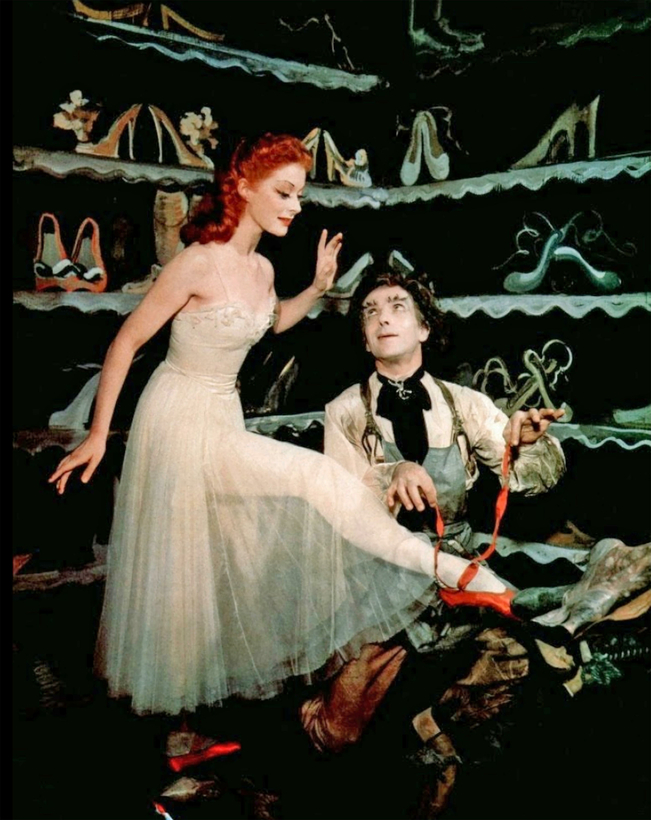Missing the swans and sylphides that have always graced the spring season? Why not give an evening to that crown jewel of the art form, The Red Shoes. The inspired work of director Michael Powell, screenwriter Emeric Pressburger, and their merry band of collaborators, this dazzling film of 1948 swept through the postwar world like a scarlet fever. Within two years it broke all box-office records. Powell and Pressburger had done their bit for the war effort with over half a dozen movies about British stoicism and heroism, among them the magnificent A Canterbury Tale (1944). The same do or die was brought to The Red Shoes, a movie about ballet.
The delicate redhead Moira Shearer, unforgettable as the ballerina to be, Victoria Page. Anton Walbrook, impossibly elegant and elitist as the omnipotent director Boris Lermontov. Marius Goring of the big blue eyes, the uncompromising young composer Julian Craster. Lyric intensity, love of art, desire. Martin Scorsese has called The Red Shoes “cinema as music.” How did a ballet movie make almost every list of the greatest movies ever made?
Lyric intensity, love of art, desire.
The plink-plink of class piano. The swish-swish of battements at the barre. The tap-tap of the conductor’s baton. Setting aside the countless perfect—and sophisticated—details with which Powell and Pressburger build the hothouse that is a ballet company (most movies about classical dance go wrong in ways large and ludicrous), The Red Shoes happens to be much more than a ballet movie. I propose you watch it again, not as a movie about dancing, but about …
Fashion
The capricious older ballerina played by Ludmilla Tchérina is super chic in Carven, and looks better in her nipped-waist suits than in her tutus. Shearer is dressed gorgeously by both Mattli and Jacques Fath. Searching for the provenance of a 1940s gown, the Vogue editor and sometime curator Hamish Bowles found his answer in The Red Shoes—the gown was in the Fath collection shown in a Paris garden. As lifestyle inspiration, the fashion designer Isaac Mizrahi has cited the breakfast scene in Lermontov’s apartment. Look closely at his monastic robe: it is embroidered with what appear to be tarot cards. Monastic too is his daywear: black suit, white shirt, ivory tie, black loafers with white vamps. For Lermontov, ballet is a religion.
Design
Interiors in The Red Shoes are beguiling. In Lady Neston’s London home, pastel swags and Recamiers reign supreme. Lermontov’s Paris apartment is spartan Second Empire—claret velvet with French-blue boiserie. In the Monte Carlo office—Secessionist chairs! The rooms of Page and Craster are a ghostly marine blue, unmoored.
Filmmaking
The Ballet of the Red Shoes is a film within the film, 17 minutes long and wildly inventive. Impressionism. Expressionism. Surrealism. Levels of consciousness are conjured with corridors of cellophane, phantasmagoric illustrated backdrops, and newspapers rising from the ground to dance in human form. The ballet is a spinning, leaping cinematic odyssey. It’s message? The passion of the artist is a kind of martyrdom.
Music
Composed, arranged, and conducted by Brian Easdale, the score of The Red Shoes may be the most marvelously coherent ever created for a movie. We hear the hallucinatory heat waves of Ravel, punctuated by train whistles, popular music, Tchaikovsky and Delibes. The music for The Ballet of the Red Shoes is a masterpiece in miniature. Easdale won the Oscar for Best Original Score.
Color
If you call a movie The Red Shoes, you care about color. And the color here—Technicolor—is glorious. I love the scene where 12 pairs of pointe shoes are laid out, all in varying shades of red, and one pair is chosen: you can see it’s the right red (Diana Vreeland would approve). Unforgettable is the scene in which Shearer, wearing an emerald-green gown, climbs the overgrown stone steps to a Monte Carlo aerie, her ascent to the realm of ballerina. And the film’s last leap—blue sky, silver steam, ethereal, final—well, Powell called it “Eight frames, but it is one of the most beautiful cuts in the film.” To see this movie at its best, you must watch it in the dark.
